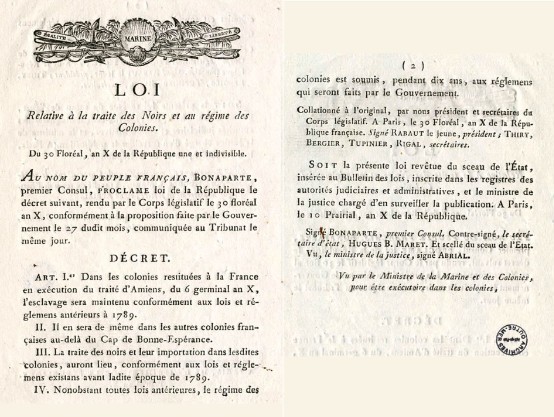On his coming to power, Napoleon did not have fixed ideas regarding slavery and the slave trade, both abolished by the Convention in 1794. On several occasions, he decided not to re-establish slavery, refusing, as he noted, to deprive Blacks of the liberty that had been obtained for them. The revolts in the colonies (including that led by Toussaint Louverture on Santo Domingo), the savvy lobbying of colonial businessmen in his entourage, and (in the end) his own indifference to the human aspect to the problem (as opposed to his keen interest in the geopolitical and economic issues) made him change his mind after the signing of the peace of Amiens with the United Kingdom and hopes of an upturn in colonial commerce. On 27 April, 1802, in a note, he sketched out the general contours of the policy to be pursued in this respect: the bringing back of slavery was part of this policy. A short law was drawn up and adopted by the administrative organs of the Consulate: in the colonies returned to France as part of the treaty of Amiens and in those colonies situated “beyond the Cape of Good Hope, slavery would be continued in conformity with the laws and regulations of before 1789, and the trade of Blacks on behalf of those above-mentioned colonies could begin again”.
It should be noted that this text did not abrogate the abolition law but in fact maintained slavery in places in which it had been impossible to abolish it, namely in the colonies of the Antilles (which were not French from 1794 to 1802), and in those colonies east of the Cape of Good Hope where the law of 1794 had never been applied. Napoleon’s intention was to unify the system in the colonies, and, to be totally clear here, effectively to reintroduce slavery, as is shown by his instructions authorising representatives of the government in Guadeloupe and in Guyana to introduce it at an opportune moment. And it was enacted in the following months. The Antilles revolted. After violent fighting, «order» was re-established apart from in Santo Domingo where independence was proclaimed. Furthermore, the legislation of the Ancien Régime was brought back. Only one consolation: France’s navy was so weak that the slave trade could not begin again on a grand scale. Napoleon himself never really interested himself in the question again, up until the First Abdication. He did abolish the slave trade during the Hundred Days (decree of 28 March, 1815), at the same time as the Congress of Vienna also proclaimed its abolition. It was to take several more decades before the abolition of slavery and the slave trade (which for France occurred in 1848) became “worldwide”.
Bullet Point #9 – Why did Napoleon bring back slavery?
Author(s) : LENTZ Thierry
Each “Bullet Point” will confront a question related to the First Empire. My remarks are designed to form the basis for debate and, I hope, research.
(Thierry Lentz, April 2018, translation PH)


